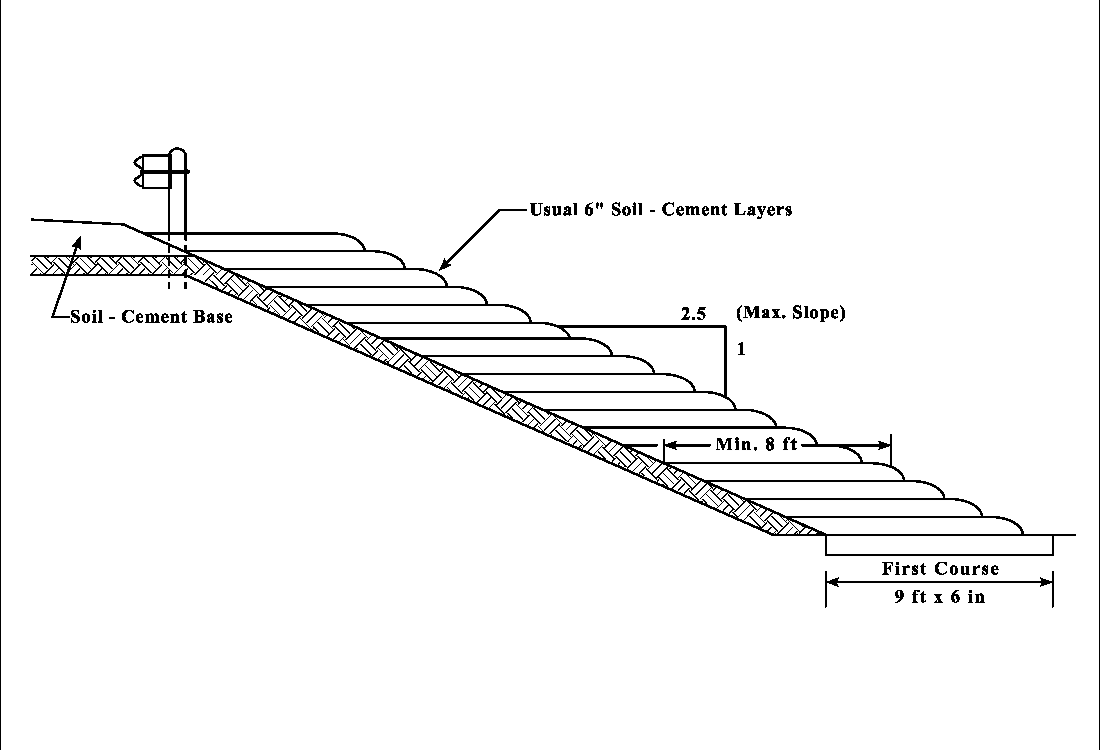Section 6: Embankment Protection
Anchor: #i1000749Introduction
The best slope protection type for a given situation depends on the conditions where the installation is to be made, availability of protection material, cost of the various types, and protection desired.
The major reservoir agencies usually can help select the best protection for a given situation.
Anchor: #i1007280Embankment Protection Location
Embankment protection is required from the toe of the highway embankment up to an elevation equal to the conservation pool elevation, plus the effects of wind tide and wave runup.
Where the toe of the roadway embankment is below the conservation pool elevation, the minimum elevation of the top of the protection should not be less than 3-feet above the conservation pool elevation. The remaining embankment above the limits of the required protection is an area of lower risk of damage from wind effects than the area affected by wind on the conservation pool. Generally, a vegetative cover with a strong root system is adequate and very economical.
Anchor: #i1000764Rock Riprap
The following elements of rock riprap should be considered:
- Anchor: #EKQEJLGF
- size – Rock riprap consists of loose rock that is dumped on the slope and distributed. The size of the rock should be large enough that it withstands the forces of wind and water directed at the slope. Anchor: #KLUELEGI
- placement – The rock should be placed on a bedding of sand, engineering fabric pinned to the slope, or both a bedding of sand and engineering fabric pinned to the slope. Bedding is primarily for the purpose of keeping the embankment material in place as the embankment is saturated and drained. Anchor: #GOEEMHGM
- keyed rock riprap – An effective rock riprap variation is keyed riprap. Keyed riprap is rock that has been placed and distributed on bedding upon the slope and then slammed with a very heavy plate to set the rock riprap in place (i.e., to key the rock together). Rock riprap is considered a rough slope when computing wave runup on the slope.
Once the wind effects are known, the weight of the median stone and the total thickness of the riprap blanket can be established using the following equations:
Equation 12-1.
Equation 12-2.
where:
- Anchor: #NLHFNNGN
- W50 = weight of the median sized stone (lbs.) Anchor: #MMLNGKGN
- γs = specific unit weight of the stone Anchor: #GKMGILGJ
- H = design wave height (ft.) Anchor: #MIKMLHIF
- KD = riprap stability coefficient, 4.37 is appropriate for TxDOT Anchor: #FMLEHJMF
- α = slope angle from the horizontal in degrees Anchor: #FHLGJNMG
- G = specific gravity of the stone material Anchor: #EPHHGNKK
- Wmax = weight of the maximum sized stone (lbs.) Anchor: #FTHIKEEG
- Wmin = weight of the minimum sized stone (lbs.) Anchor: #LLHFMNFM
- T = thickness of the riprap layer (in.) Anchor: #OTJFGIFL
- ç = number of layers of W50 (typically taken as 2) Anchor: #KNIHLMII
- KÄ = layer thickness coefficient (typically taken as 1)
Soil-Cement Riprap
Soil-cement riprap consists of layers of soil cement on the slope placed in prescribed lifts (Figure 12-3). This type of protection provides excellent slope protection. However, inspection and maintenance is necessary, especially at the reservoir water surface elevation that exists most of the time.
Figure 12-3. Soil Cement Riprap Specifications
Anchor: #i1000905Articulated Riprap
Articulated riprap is usually fabricated so that the individual elements are keyed together, and then secured by connecting cables or strands run in two directions to hold the units together. Articulated riprap is usually placed on a filter bed, engineering fabric, or both. The riprap is so named because it is flexible and can move as a unit with the slope and still remain intact. There are several commercial sources of articulated riprap. Each should be evaluated for price, performance, and experience.
Anchor: #i1000915Concrete Riprap
Concrete riprap usually consists of slope paving of 4 to 6-inches in thickness. Concrete riprap ordinarily is not recommended for embankment slope protection for highways within a reservoir. This is because the hydrostatic head that can exist in the embankment after it is wet cannot be relieved adequately through the concrete riprap. The riprap may bulge and fail because it does not have the structural integrity necessary to withstand the hydrostatic head of the trapped water.
Concrete riprap can be useful for short sections when placed on a bed of coarse filter material with numerous drain holes located in the riprap, and in an area where the embankment does not have standing water on the slope. There should not be constant differentials in the water surface that might cause prolonged periods of wetting and drying of the embankment.
Anchor: #i1000930Vegetation
The use of vegetation with large, strong root systems is a common and economical way to protect slopes. Vegetation protection can be useful on embankment slopes in a reservoir where wind effects are mild.


